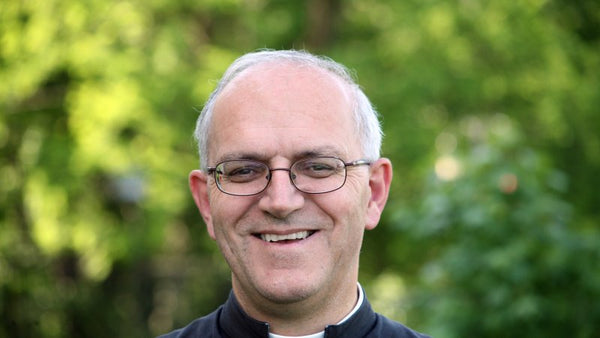Christ, the Gardener of our Souls

But Mary stood at the sepulchre without, weeping. Now as she was weeping, she stooped down, and looked into the sepulchre, and she saw two angels in white, sitting, one at the head, and one at the feet, where the body of Jesus had been laid. They say to her: Woman, why weepest thou? She saith to them: Because they have taken away my Lord; and I know not where they have laid him. When she had thus said, she turned herself back, and saw Jesus standing; and she knew not that it was Jesus. Jesus saith to her: Woman, why weepest thou? Whom seekest thou? She, thinking it was the gardener, saith to him: Sir, if thou hast taken him hence, tell me where thou hast laid him, and I will take him away.
This scene, the Noli me tangere, has been depicted in countless works of art and has fired the minds of saints, spiritual writers, and common faithful alike. But what does it mean? Why is it that Mary Magdalene mistakes Christ for a gardener?
Part of the key to understanding and unwrapping the great depth of this mystery will come from an understanding of the Church’s prayers during Lent in general, and Holy Week in particular. In the preface of Passiontide, the liturgy states, “Who didst establish the salvation of mankind on the tree of the cross: that whence death rose, thence also life might rise again, and that he who overcame by a tree, by a tree also might be overcome…” Let’s briefly look at this statement and understand what Holy Mother Church is telling us in her liturgy here.
What stands out, what the Church presents to us, is the contrast between the work of Christ in His Passion and Death, and the Fall of man in Eden. Christ is conquering by His obedience on the tree of the Cross whereas Adam plunged man into ruin by his disobedience with the tree of the Knowledge of Good and Evil. Christ is countering the work of the Devil and the sin of Adam by His perfect obedience to the Father, and in such a way that it repairs in a specific way (whence death rose, thence also life might rise again) the sin of Adam.
The Church is even more specific during her liturgy of Good Friday when she states, “Through a tree we were enslaved, and through a holy Cross have we been set free: the fruit of a tree led us astray, the Son of God bought us back.” Again, we see that though Christ is suffering for all the sins ever committed, and that ever will be committed, to make satisfaction to the Father, He is also undoing, in a very specific way, the work of Satan in Eden, from which sin and death entered the world and made us all the slaves of our enemy.
So, what are we to make of this scene with Magdalene, in light of the above? Is it simply a mistake since she is in a garden looking for her Lord and it’s reasonable to assume that the man might be the gardener, or is there something else going on here?
Let us hear first from St. Jerome in his Homily 87: “When Mary Magdalene had seen the Lord and thought that He was the gardener…she thought that He was the gardener; she was mistaken, indeed, in her vision, but the very error had its prototype. Truly, indeed, was Jesus the gardener of His Paradise, of His trees of Paradise.” Now let us hear from St. Gregory the Great in his sermon on this same passage. “Perhaps this woman was not as mistaken as she appeared to be when she believed that Jesus was a gardener. Was he not spiritually a gardener for her when he planted the fruitful seeds of virtue in her heart by the force of his love?” It is clear that the Fathers are telling us that Mary Magdalene’s “mistake” is for our edification. In St. Jerome and St. Gregory we can truly say that Christ is the gardener, or as St. Gregory the Great puts it, a spiritual gardener. And what is He tilling? Our souls, so that planting virtue and watering it by grace, he will raise up “spiritual trees” as St. Jerome calls it.
Now, to pull it all back together. How does this fit with the above questions of the counter balance between Adam and Christ? Adam, who was given dominion over all the Earth, squandered his glory by sin. From that point forward, he would only bring forth fruit from the Earth by the sweat of his brow. It would be hard work, contrary to the initial order established by God, where Adam was master of the garden of Paradise. He was, in a sense, the gardener, but through his bad stewardship, and his disobedience, he betrayed his authority and his God.
Contrast this with Christ, who is mistaken for the gardener. He has just done the work of bringing forth fruit and watering His garden through His Passion, and Death and complete obedience to the Father. Now that He has triumphed over the world, the flesh, and the Devil, we find Christ exactly where and how we should expect to find him; as the new Adam, in a garden, tilling the gardens of our souls.
Leave a comment
Comments will be approved before showing up.
Also in Angelus Press Blog

Angelus Press Website Update is Complete

Angelus Press Website Updates for Wholesale Accounts

Fr. Dominique Bourmaud Passes Away
With great sadness, the U.S. District of the Society of Saint Pius X (SSPX) announces the passing of Fr. Dominique Bourmaud. He went to his eternal reward in the early hours of Saturday, September 4, 2021.
Eternal rest grant unto Fr. Dominique Bourmaud, O Lord, and let perpetual light shine upon him. May he rest in peace. Amen.

Brent Klaske
Author
Director of Operations at Angelus Press. I have worked in Catholic publishing for more than 20 years. I currently live near St. Marys, KS with my wife and 10 children.